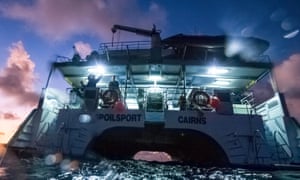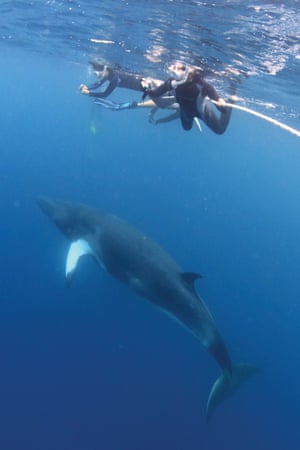A sparkling encounter: swimming with dwarf minke whales | Travel
It’s a rare â€" and foolhardy â€" tourism operator that talks in guarantees. Your satisfaction is staked on forces outside their control and their TripAdvisor review hangs in the balance â€" it’s in their interests to manage your expectations. This is never truer than when what’s being marketed is proximity to wild animals, more mercurial than even the weather.
Last year I went on a three-hour humpback whale-watching trip off Sydney Heads with a friend from out of town. After an hour and a half, the whales remained elusive, and the ship’s captain became increasingly bullish in pursuing possible sightings, charging directly into headwinds and across choppy seas.
We did glimpse one or two whales eventually â€" at least I did, as the only punter aboard the boat not debilitated by seasickness, my gaze fixed on the horizon as I handed plastic bags to my friend and removed them full. A group of English tourists next to me spoke of the trip in terms one might use for the Hunger Games, wondering if they could bring its end forward by faking a heart attack or telling a crew member they were “allergic to the seaâ€.
When the captain announced we’d be back in the harbour in 20 minutes, a cheer went up.
Technically, though, we had seen some whales.
Nine months on, the memory lingered at the back of my mind as I boarded Spoilsport, a 30m catamaran, in Cairns one night. Along with 27 other guests (and 12 crew members), I would be spending the next few days on the Great Barrier Reef. We were a diverse bunch, of varying nationalities and experience levels â€" from seasoned divers shlepping their own gear halfway across the globe, to some for whom just being aboard a boat spurred some trepidation.
We’d been drawn to this four-night, five-day package with Mike Ball Dive Expeditions for the same reason. Its selling point was the promise of swimming with dwarf minke whales, which visit the northern outer reef in large numbers in June and July. Well, not promise, per se â€" but high probability.
The itinerary would be dictated by the whales, taking in areas they were known to frequent to maximum our chances of sightings. If we were unlucky at their regular haunts, we’d spend up to two hours at a time searching for them further afield. Since commencing minke whale “expeditions†(Mike Ball himself had corrected me gently when I’d referred to “tripsâ€) in 1996, there had been a 98% success rate. The first year, they’d hired spotter planes, but never since: there was no need.
Promising odds, indeed. But there were still distinctions to be made beyond the binary of sighted or not â€" like how many whales seen at once, and for how long. Ball’s website said the largest pod his operators had come across had been 28 animals; the longest encounter, 10 hours. It also said “minke whales are wild animals and can be unpredictable; past success does not guarantee future successâ€.

I knew better than to hope of a repeat performance. It said more about my expectations of wild animals than it did my expectations of Mike Ball and Spoilsport’s eminently professional crew that I was prepared to see as many whales, and as much of them, as I did on my disastrous trip last year. Better to set your sights low and be delighted than to be disappointed, I thought as I got ready for bed in my comfortable cabin.
And whatever happened, I had some great diving to look forward to. We were bound for the Ribbon reefs, a chain of 10 individual reefs north of Port Douglas on the edge of the continental shelf. Much has been said about the damage done to the Great Barrier Reef by coral bleaching, cyclones and crown-of-thorns starfish, and especially in the northern third, where coral cover had declined to just 10%, a level not seen in over 30 years.
But Ball had told me that what a visitor to the reef might see of the devastation depended on where they looked: one patch of coral might have suffered significant bleaching, another right next to it might not. Likewise, some dive operators had been disastrously impacted by the recent damage. Being in the “liveaboard†business of accommodating guests for days at a time, Spoilsport was able to travel further to reach more remote, healthy reefs than those that might accessible to day-trip operators.

We would be visiting some of the Great Barrier Reef’s most popular dive sites: the Lighthouse Bommie, a 20m pinnacle of coral emerging from the seafloor, known for olive sea snakes as thick as your arm; Steve’s Bommie, a coral memorial garden, complete with a plaque commemorating the late freediver for which it was named (apparently he died after a motorbike accident); Gotham City, with its large populations of batfish, where we’d do one of our two night dives.
All up, we’d be given about 12 opportunities to dive over the next three days. Then, on the last morning, we’d disembark at Lizard Island to catch a light plane back to Cairns, flying at a low level over the Great Barrier Reef for one last, bird’s-eye look.
By the time I woke up on our first full day of diving, all trace of land had vanished from the horizon visible from my cabin window â€" Spoilsport had motored more than 200km through the night to reach the Ribbon reefs by breakfast. We would soon be attempting our first minke swim, crew having spotted them in our vicinity. Jelle, the trip director, briefed us on what we could expect.
Swimming with whales is against the law in many countries due to concerns over its potential impact on either party, making this a one-of-a-kind wildlife tourism experience. Spoilsport is one of only a handful of vessels endorsed by the Great Barrier Reef Marine Park Authority to conduct whale swims, in accordance with a code of conduct and Australian legislation.
Key to the sustainability of the industry is that it is led by voluntary approaches by the whales â€" the interaction begins and ends as they please. We were on strict instructions to remain quiet and calm on the surface. The number one rule, Jelle said, was “do not approach the whales. They will come to youâ€.
I was struck by his use of “will†â€" surely a cheque he might not be able to cash, I thought.
“The pool is open,†said Jelle, rather grandly.
On the dive deck, I wriggled into my wetsuit, jammed on fins and, easing myself into the water, edged down one of the two ropes trailing on buoys behind the boat.
It was mere minutes before a whale emerged.
The first I saw of it was the white blaze on its shoulder, at first a shimmer in the soup that brightened to turquoise as the animal approached.
Then there was another â€" and another, sleek and inquisitive, all apparently close to the maximum size of dwarf minke whales of about 8m.
At first they kept their distance, circling beneath us snorkellers with obvious caution. Bobbing behind Spoilsport, we struggled to keep flat on the surface, as instructed. Over the minutes, then hours, the whales became more bold â€" I had to admit, exactly as billed.
What seemed to me to be the largest of the three â€" a female, we were later told, with a slight nick in her dorsal fin â€" was particularly brazen, passing within metres of us on her circuit. On some circuits she’d cruise by, regarding us with lazy inquisitiveness from eyes that bulged from both sides of her head; others she’d suddenly pick up speed with a pump of her tail, a marbled torpedo of black, white and grey.

By the end of the interaction, they were so regular, so casual in their approaches, it was difficult to keep all three in frame. I’d be tracking one as I wobbled on the surface when I’d be taken by surprise by one beneath or behind â€" really there, not recalled from a nature documentary. Sometimes I’d lift my head to catch the whale as it surfaced for air, just to connect what I was witnessing below water with the more familiar view of a dorsal fin.
Back onboard Spoilsport, there was a shared sense of jubilation, even giddiness â€" we sparkled from the encounter.
“One-of-a-kind†gets bandied about so freely by tourism operators it means nothing at best, and at worst sets a low bar. In this case, no blurb could have done it justice. It was the kind of experience that it was hard to believe could be attained with mere money. One hesitates to say transcendental â€" but certainly transcendent-adjacent.
We weren’t to know then, still damp from our first swim, that we’d go on to have five more encounters in the coming days, totalling 13 hours spent in the company of more than 40 whales.
Now that was what you’d call bang for the buck.
• The writer travelled courtesy of Tourism & Events Queensland

0 Response to "A sparkling encounter: swimming with dwarf minke whales | Travel"
Posting Komentar